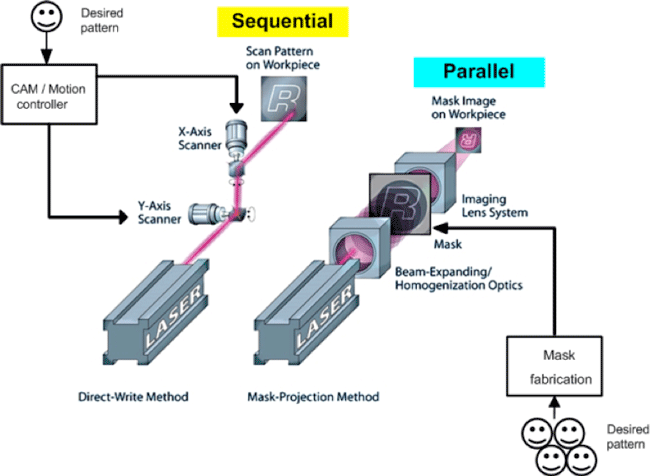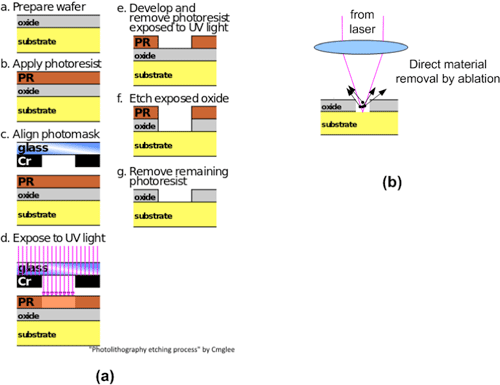November 3, 2015
This article explains how lasers compare to traditional methods for fabricating diagnostic consumables.
Glenn Ogura
In Part 1 of this article, you learned about the benefits of miniaturization for diagnostic consumables, and that many of them are now being fabricated from polymers and glass, rather than silicon, ceramic or printed circuit boards. This brings laser micromachining into play, as it offers the features necessary for the challenges of machining consumables in fields such as molecular diagnostics, biosensors, single cell analysis, sequencing, and point-of-care.
Part 2 provides an overview of the fundamentals of laser micromachining and discusses how lasers compare to traditional methods for fabricating diagnostic consumables.
Fundamentals of Laser Micromachining
The microfabrication of diagnostic platforms uses many different manufacturing techniques such as photolithography, micro-molding, etching, and mechanical deposition. These microfabrication methods, however, have drawbacks such as a manufacturing process requiring multiple steps, long prototype lead-time, high tooling costs or material limitations. Laser micromachining technology, defined as using a laser to drill, cut, and etch materials with feature sizes as small as 1 micron, is not only a rapid prototyping method, but also is scalable for volume manufacturing in materials such as polymers and glass.
Short Wavelengths and Ultrashort Pulse Lengths
To achieve small feature sizes without melting the material, laser micromachining deploys lasers with short wavelengths, short, or ultrashort pulse lengths or both. While traditional CO2lasers run at a wavelength around 10 micron, lasers used in the micromachining world operate in the ultraviolet spectrum that is up to fifty times shorter, ranging from 193 to 355 nm. As a rule of thumb, the smallest achievable feature size is roughly twice the wavelength so it's easy to see how having short wavelengths plays a vital role.
Equally important is the amount of time that the laser pulse lasts on the material; the amount of heat can melt or deform the machined feature, which affects not only the quality but the achievable dimensional tolerance. It is easy to understand that a sharply defined edge is more precise than a jagged edge where there is no clear definition of where the edge starts and where it ends. Lasers operating in the micromachining world have pulse lengths ranging from femtoseconds to nanoseconds, at least three to six times shorter than traditional CO2lasers.
It is the combination of the short wavelength and short pulse length that allows lasers to drill, cut, or etch materials such as polymer or glass with features as small as 1 micron. The short wavelength in most materials results in laser light being absorbed in the very shallow layer of the material and the short pulse length minimizes the amount of the heat affected zone (HAZ) surrounding the machined feature. Lasers that fit these criteria are excimer lasers, diode-pumped solid-state lasers (DPSS) and picosecond lasers. Industrial femtosecond lasers are not currently available at the ultra-violet wavelengths at reasonable power levels, but their unique nature (ultrashort pulse length) makes them attractive for many micromachining applications.
Sequential or Parallel Laser Processes
Other than their specific wavelength or pulse length, laser processes can also be classified as being sequential or parallel. Sequential operation is defined as a laser beam focused to a small spot on work piece and the beam "traces" the pattern to be machined. This "direct write" process is usually employed for lasers with round Gaussian beams, like diode-pumped solid-state lasers (DPSS), picosecond and femtosecond lasers which operate at repetition rates from kilohertz to megahertz, meaning the laser beam is pulsed on and off at very fast rates. Coupled with high speed scanning mirrors such as galvanometers or polygons, fast machining times are realized.
Parallel operation is defined as a laser beam illuminating a mask with a specific pattern of openings, such as an array of holes, and the entire pattern is then projected by a downstream lens onto the work piece. As opposed to the sequential operation where one hole is drilled at a time, this "mask projection" technique allows multiple holes to be drilled simultaneously, resulting in fast machining time. Excimer and TEA-CO2lasers with large beams of quasi-uniform profiles are used in this parallel processing approach.
|
Figure 1. Sequential and parallel laser micromachining |
How Laser Micromachining Stacks Up
There are many microfabrication processes to make diagnostic consumables such as sample preparation filters, biochips, biosensors and microfluidic chips in materials such as polymer and glass.
Each process has its own advantages and limitations, yet laser micromachining is emerging as an enabling technology that may offer improved instrument performance or cost-savings for many diagnostic platforms or consumables.
Laser Micromachining vs. Photolithography
Photo-lithography is a well-known scalable process to fabricate silicon-based microelectronic chips for today's data-hungry devices such as mobile phones, computers, e-readers and music players. This is both an additive and subtractive process.
This multi-step process (Figure 2A) involves coating an oxidized silicon wafer with a thin photoresist layer. After the resist is exposed to light of appropriate wavelength through a reticle pattern, the photoresist is developed: the unexposed or exposed areas of the photoresist are removed, depending on the type of photoresist (positive or negative). It leaves a pattern of bare and photoresist-coated regions on the wafer. Then the wafer proper is patterned to a desired depth by a (usually wet) chemical etch process through the openings in photoresist, followed by stripping away the remaining photoresist with a solvent.
For biocompatibility or cell viability reasons, diagnostic consumables fabricated from polymers or glass are often preferred over other materials such as silicon, ceramic or metals.
Compared to photolithography, laser micromachining is a single step process (Figure 2B) where the laser directly removes the material from the workpiece. Laser microfabrication offers the benefits of alternate material choices (such as polymer and glass), quicker prototyping time (direct single step process), and lower manufacturing costs, because several manufacturing steps are eliminated. As a result of material interaction, laser micromachining is limited to a minimum feature size of approximately 1 micron with a machining depth no greater than 1 mm.
Laser Micromachining vs. Plastic Injection Molding
Plastic injection molding is a cost-effective method to fabricate micro-patterned plastic consumables in high volume. Although the initial tooling cost is high and the lead-time is lengthy, molding is certainly attractive to produce high volumes of plastic consumables. Polymer consumables, however, are not always a monolayer, but can include also multiple layers of different material types, such as organic chemistries, enzymes, and metals. Naturally, this complicates the molding process. Or consider applications where the through hole diameter is less than 150 microns, making it very challenging and prohibitively costly to insert fragile pins in the cavity wall. Or imagine applications where the hole profile is not a straight wall, but a "trumpet" profile where the entrance hole has an exaggerated mouth compared to the much narrower exit hole. In such cases, laser micromachining offers the benefits of drilling small through or blind holes with tailored hole profiles. Also, the two processes can co-exist where laser micromachining is used as a secondary process on a molded part.
Laser Micromachining vs. Versus Ion Track-Etching
Track-etching involves the exposure of a roll of polymer (polycarbonate, polyethylene terephthalate (PET) or polyimide) to a high energy beam of heavy particles, followed by chemical etching. One of its advantages is the ability to produce very small pore sizes ranging from 0.01 microns to 30 microns in diameter. Micro hole arrays produced by the track-etched method are also very cost-effective when processed in a roll format. The drawback of this method is random distribution of hole locations with large variations in inter-hole distances, all the way to occurrence of multiple-hole overlaps resulting in out-of-spec hole sizes. Laser micromachined polymer membranes and filters offer the benefit of consistency, where every hole in the array is the same shape and diameter and the pitch between holes is constant.
Laser Micromachining vs. Wet/Dry Etching
There is a variety of wet and dry etching methods where the solid surface, typically silicon or glass, is etched in the liquid or gas or vapor phase, ion-bombarded or by chemical reaction. Similar to photolithography, however, many of these techniques require some sort of contact mask to be laid down on the work piece prior to etching away the unwanted material, thus extending the number of manufacturing steps. Liquid HF etching is also isotropic, meaning the material is etched in every direction, resulting in beveled holes at the exit. As a rule of thumb, twice as much of the material is etched horizontally than vertically, meaning a feature with 100 microns of depth will also have 200 microns in width at exit.
On the other hand, laser micromachining is quite directional, so that the feature is drilled in the intended direction only and does not require a contact mask or resist to be laid down on the work piece. The laser does produce a half angle taper of approximately 5 degree, which is critical when the pitch between features gets smaller. The single-step laser process also lowers costs by eliminating a number of manufacturing steps.
|
Figure 2. (a) A photolithography process, in this case, 7-step, vs., (b) 1-step direct laser micromachining. |
Laser Micromachining vs. Particle Blasting
Aside from using HF etching to machine glass, particle blasting is a common technique to drill holes in glass but the fragility of the glass limits powder blasting to slides of approximately 500 micron or thicker.
With careful part handling, lasers offer the advantage of drilling holes in thin glass with no thickness limitations.
Laser Micromachining vs. Mechanical Deposition
Aside from subtractive methods such as laser micromachining, there are many additive methods such as screen printing, physical vapor deposition, chemical vapor deposition, and 3-D printing, to name a few. Each method has advantages and disadvantages such as the available materials set, scalability to production and smallest feature size. In the case of screen-printing, a contact mask defines the pattern to be created, but as features become smaller, the deposited material may creep under the mask and spoil the pattern. 3-D printing shows promise but today it is not scalable for volume production and has a limited material set.
On the other hand, with the right wavelength and pulse length, lasers can machine a wide pallet of materials with little, if any, restrictions. Lasers can machine most polymers, glass, ceramics, and metals. Lasers have been used to drill ink jet printer nozzles for the ink jet printer industry so there's an existing model to scale up for production.
Up for the Challenges
As the field of diagnostics grows more complex and continually improves the identification, treatment and prevention of illnesses, manufacturers must rise to the challenge of creating smaller, more sophisticated instruments. The precision offered by laser micromachining make it a necessary technology for the fabrication of diagnostics consumables in such fields as molecular diagnostics, biosensors, single cell analysis, sequencing, and point-of-care.
Glenn Ogura is the SVP Market Development at Resonetics (Nashua, NH).
Stop by Resonetics booth (#634) at BIOMEDevice San Jose, December 2-3. |
About the Author(s)
You May Also Like




